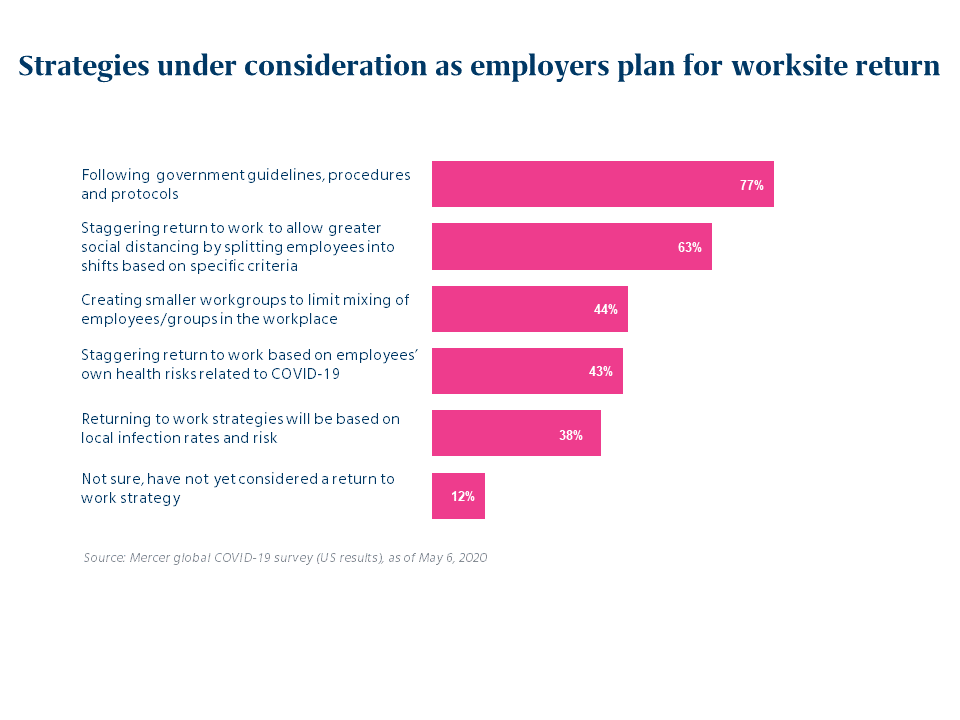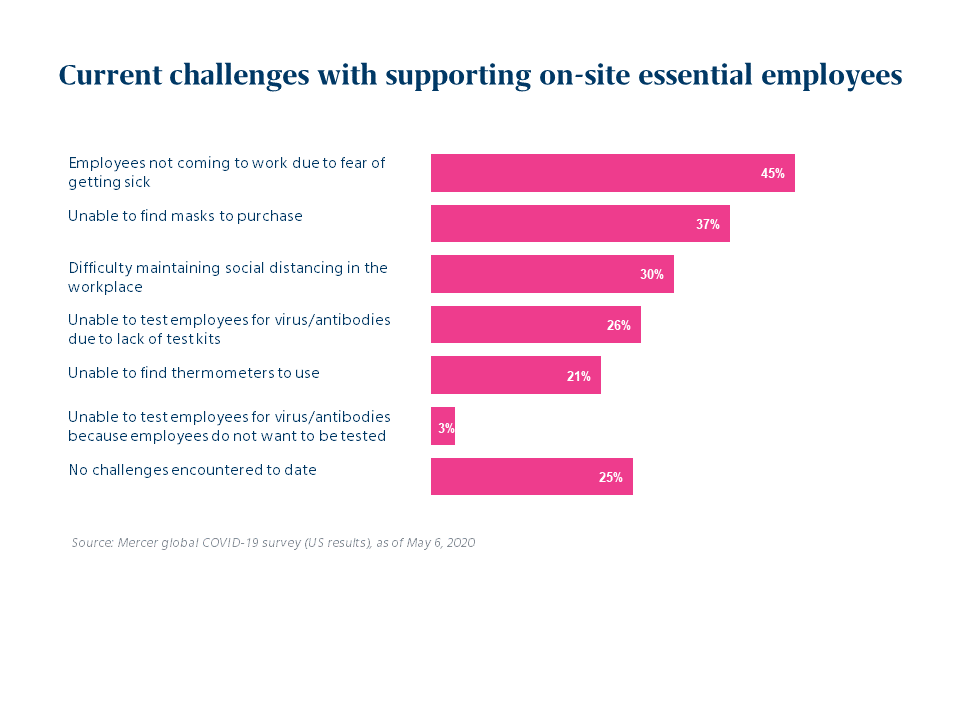Worksite Return: Lessons from Essential Businesses

As US employers ramp up planning for the return of their non-essential workforces to worksites in the midst of the COVID-19 crisis, a new Mercer survey found some significant challenges they may face. The survey asked employers of essential workers who have remained at their worksites throughout the pandemic about the steps they have taken and their experiences over the past few months. Most notably, nearly half (45%) of responding employers with essential workers have had issues with employees not coming to work because they are afraid of getting sick. Not surprisingly, this problem is more widespread in industries like retail/wholesale (84%), manufacturing (64%), and healthcare (57%), where the risk of exposure is higher.
For employers planning the return to worksites, this finding underscores that their first priority is to develop a comprehensive plan to keep employees safe at work – and to communicate this plan clearly to employees to allay their fears.
Physical distancing requires creative thinking
The most important safety consideration, by far, is to maintain adequate distancing. While nearly all employers of essential workers have made changes to ensure employees keep the proper distance from coworkers and customers, nearly one in three (30%) say they have had problems doing so.
There is no one distancing solution that will work in all situations, so employers will need a plan that best suits their specific workplace and staffing needs. Overcoming the physical distancing challenge may mean fewer employees in a worksite at a given time. Nearly two-thirds of survey respondents (63%) planning for return to worksites are considering “staggered returns” with measures such as having employees whose last names start with A-M working on certain days and N-Z working other days. Other employers (44%) say they will create smaller work groups in order to limit the mixing of employees and groups in the workplace at the same time.

Worksite screenings
Interestingly, while 43% of respondents with essential workers say they have conducted COVID-19 screenings and assessments on-site, only about one-third (35%) of the respondents planning for return to work expect to take such measures, most commonly with temperature screenings (26%) and/or by administering a symptom questionnaire (20%). Temperature screening will be seen more often in larger organizations -- 37% of respondents with 5,000 or more employees are considering it, compared to just 19% of those with fewer than 500.
Although antibody testing is receiving heightened attention, just 4% of all respondents say they are planning to conduct serology screening for antibodies. This low percentage may reflect concerns about the reliability of the tests as well as the fact that much is still unknown about immunity to COVID-19. Just 3% say they will screen for the presence of the virus.
Wearing masks
Nearly two-thirds of survey respondents (63%) planning for the return to the workplace say they will provide employees with masks. However, based on the experience of employers with essential workers, this could be challenging; more than one-third (37%) of respondents with essential workers reported that they have had difficulty finding enough masks to purchase.
To be an effective strategy, everyone in a worksite needs to wear a mask to ensure that any person who is carrying the virus without being aware of it is wearing one. While it is concerning that employers report difficulties in purchasing masks for their essential workers, employers should be aware that general-use face masks that improve respiratory hygiene do not need to be surgical masks or N-95 masks; those should be reserved for healthcare workers. The CDC has noted cotton masks can be used for this purpose.
Continuing work-from-home policies
With employers facing the complexity of staggered returns, variances of testing and mask availability, many have speculated that keeping non-essential workers “virtual” will be a popular and effective way for employers to ensure social distance and safety. The reality is that not all employers can, or desire, to continue virtual working arrangements. While 38% say that employees will continue to work virtually in the short-term and return to on-site working when deemed safe, only 8% say they will continue to allow most employees to continue to work virtually as much as possible, regardless of social distancing rules. Even among respondents in high-tech companies, where virtual work was relatively common before the pandemic, only 14% say they would support long-term virtual working for all employees.
History has shown that during a crisis, employers that put their people first and interact with them empathetically emerge with a stronger, more engaged workforce. For many employers, leading with empathy will mean accepting that not all employees will be ready to return to the worksite once it opens.
It’s important not only to communicate to employees the steps you have taken to ensure their safety, but also to acknowledge their apprehension about returning to the worksite, whether it is about safety, family obligations or other legitimate concerns.
About the survey
All survey results cited above are based on responses from 735 US employers that participated in a global online survey through May 6, 2020. Employers of all sizes are included: 37% of respondents have fewer than 500 employees; 39% have 500-4,999, and 24% have 5,000 or more. The survey opened on April 20 and is ongoing. Employers may participate in the survey and view live results on the survey website.

